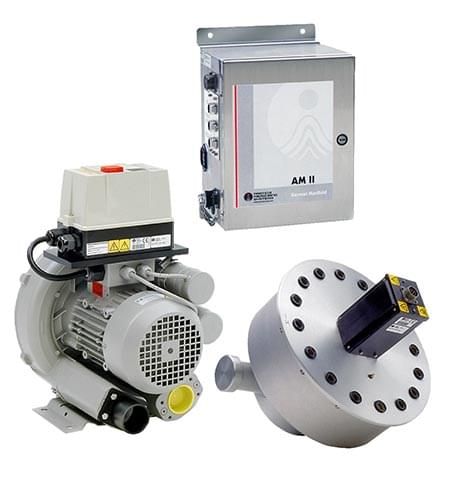Aerosol Manifold Particle Monitoring: Traditional Limitations
Particle Measuring Systems (PMS) has developed a system that resolves traditional sequential particle monitoring issues when using an Aerosol Manifold. Using the Lasair III 110 Airborne Particle Counter and Particle Measuring Systems’ AM II Aerosol Manifold, combined with Facility Net FMS data software, cleanroom operators can now effectively use this facility monitoring system.
In traditional aerosol manifold cleanroom particle counting systems, a powerful pump pulls air simultaneously from as many as 32 different monitoring locations, with each location as far away as 125 feet. This large cumulative length of tubing, plus the volume of air being moved, requires the pump to create a strong vacuum. As a result, the airborne particle counter samples air from the manifold at a vacuum. The particle counter no longer draws air at room pressure as it would if no manifold were being used.
This increased vacuum (i.e., lower pressure) in the particle counter causes an error in the measurement of ambient particle concentration. A 1.0 CFM particle counter is designed to generate a 1.0 CFM flow at a constant velocity at the sample inlet pressure. In standalone (non-manifold) particle monitoring use, the sample inlet pressure is essentially the same as the atmospheric pressure, so the unit maintains a 1.0 CFM flow, plus or minus its nominal tolerance (e.g., 5%).
With an aerosol manifold attached, however, the entire particle monitoring system operates at a lower than ambient pressure. This is due to the vacuum required to pull air through the long leng ths of manifold tubing. As a result, the 1.0 CF sampled at the inlet will have a lower concentration of particles than observed in 1.0 CF of ambient air. This means the particle count per cubic foot with a manifold will be proportionately lower than if sampled directly from the ambient air.
ths of manifold tubing. As a result, the 1.0 CF sampled at the inlet will have a lower concentration of particles than observed in 1.0 CF of ambient air. This means the particle count per cubic foot with a manifold will be proportionately lower than if sampled directly from the ambient air.
Over the years, airborne particle counter users have employed a variety of techniques for compensating for this undercounting phenomenon. The most common has been, upon installation, to increase the pump speed so the equivalent ambient volume is closer to the nominal 1.0 CFM. A few manufacturers have also tried using a mass flow controller to servo-control the pump. Such controllers automatically increase the volume flow to ensure that the particle counter samples the target mass. Unfortunately, both of these techniques require increasing the velocity through the sample chamber. Increasing sample velocity causes two problems:
- Traditional particle counters lose its calibration, to the point that it no longer meets JIS specifications.
- Particle-sizing errors, which can result in 40% underreporting in the first channel.
These compensation techniques are not only inaccurate but result in additional errors. Particle Measuring Systems has developed an aerosol manifold system where these counting errors are automatically eliminated and counting accuracy assured.
Learn more… Get the full paper.
Ready for an Aerosol Manifold System?
